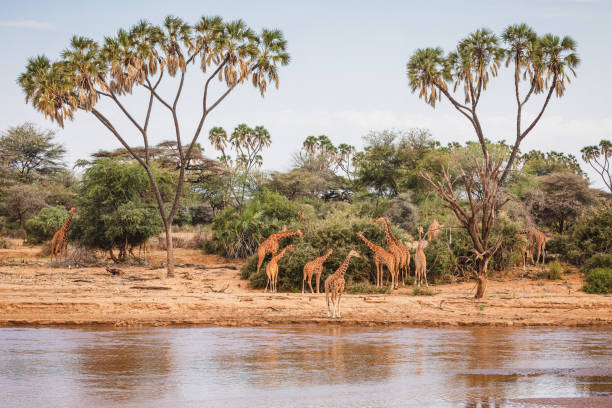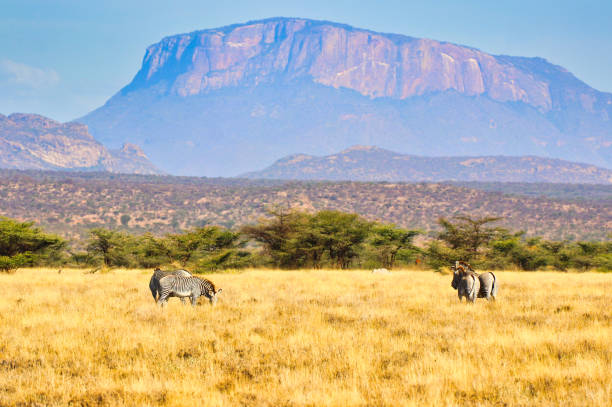History of the Reserve.
Firstly, we must know how Samburu National Reserve, Kenya came to be. The Samburu tribe is behind the name Samburu National Reserve. This tribe is semi-nomadic and has a long history in the region. Additionally, they have preserved their customs and traditions despite the influence of modern society. The Samburu people create their unique attire using red ochre. Additionally, they are known for their warrior way of life. The Samburu National Reserve is where they raised the famous lioness Elsa along with the Meru National Park. Elsa received care from conservationists George Adamson and Joy Adamson while in the Reserve. Elsa gained fame through the highly successful book and film Born Free.
Wildlife in Samburu National Reserve, Kenya.
Secondly, the Reserve is famous for the Samburu Special Five. They include the Grevy Zebra, Somali Ostrich, Reticulated Giraffe, Gerenuk, and Beisa Oryx. In fact, these animals are found only in this Reserve. They are endemic to this region of Kenya. Additionally, the Big Five are also present in the Reserve. The Reserve has about 75 different kinds of mammals and numerous bird species.

Activities in Samburu National Reserve, Kenya.
Samburu National Reserve is a great option if you are looking for a safari destination off the beaten path. The Reserve is home to some of the most beautiful scenery in Kenya, teeming with wildlife. The Reserve is also a great place to learn about the Samburu culture. Indeed, you will get to experience the beauty of the Kenyan bush. Here are some of the things you can do in Samburu National Reserve:
- Game drives: This is one of the best ways to see the animals in the Reserve. Furthermore, you will view elephants, lions, giraffes, zebras, and other animals.
- Bush walks: Bush walks are a better way to get up close to the animals in the Reserve. You will see animals you could not see on a game drive. They include dik-diks, oryx, and rhinos.
- Hot air balloon rides: Hot air balloon rides offer stunning views of the Reserve. Moreover, you will see the park from a bird’s eye view. Alternatively, you will spot animals you could not see from the ground.
- Visit the Samburu village: The Samburu village is a great place to learn about the Samburu culture. You will see traditional Samburu homes, meet the Samburu people, and learn about their way of life.
Location of the Reserve.
Samburu National Reserve is between 800 and 1,230 meters above sea level in Samburu District. The Reserve is located north of the equator. It has an area of about 165 square kilometers or 64 square miles. Samburu National Reserve is part of a much wider ecosystem with the adjacent Buffalo Springs and Shaba National Reserve.
Habitat and weather Conditions of the Reserve.
The Ewaso Nyiro River marks the southern border of the Samburu National Reserve. The desert and the semi-arid area around the reserve have a dry, warm temperature. This Ewaso Nyiro River is the only permanent water source in this protected area, even during the dry season. Furthermore, the river is important for the survival of all the Reserve’s animals.
The two main rainy seasons typical to Kenya also apply to Samburu. Brief rains occur in April through May and September through November, but with plenty of sunshine in between.
Samburu National Reserve, Kenya Park entry fees.
The Park Entry Fees to the Reserve are as follows;
- Non-Residents are USD 70. USD 40 per child under the age of 12 years old per 24hrs.
- East African Residents KSH 1000 per 24hrs.
- Kenyan Citizens KSH 500 per person per 24hrs.
The tourist type of residency determines the Reserve entrance fees. There are three levels of entrance fees. Citizens, residents, and non-residents of Kenya.
- Citizens include Kenyans with current national identification cards.
- Residents are people who live in East Africa or people with work permits issued by the government of Kenya.
- Non-Resident refers to foreign tourists who do not reside in Kenya.
Accommodation in Samburu National Reserve, Kenya.
Accommodation in Samburu National Reserve ranges from budget camps to mid-range camps, right up to safari lodges and luxury accommodations. The camps offer tented or chalet-style accommodation. Without a doubt, pricing will hike up to USD1000 per person sharing per night during the high season. Rates average from USD700 to USD800 per person sharing per night. With such a large rate scale, a value-for-money safari at Samburu National Park is possible.
Undeniably, if you plan to visit Kenya, include a Samburu National Reserve Safari on your bucket list. The park is a great place to see animals and experience the beauty of the Kenyan bush. Moreover, you can learn about the Samburu culture. Here are some tips for your trip to Samburu National Reserve in Kenya;
- Firstly, the best time to visit Samburu National Park is to avoid the rainy season. You can visit from June to October.
- Secondly, several lodges and camps in Samburu National Park offer luxurious accommodations and excellent dining.
- Thirdly, pack plenty of sunscreens, bug repellant, and a hat.
- Finally, the park is remote, so pack everything you need for your stay.

